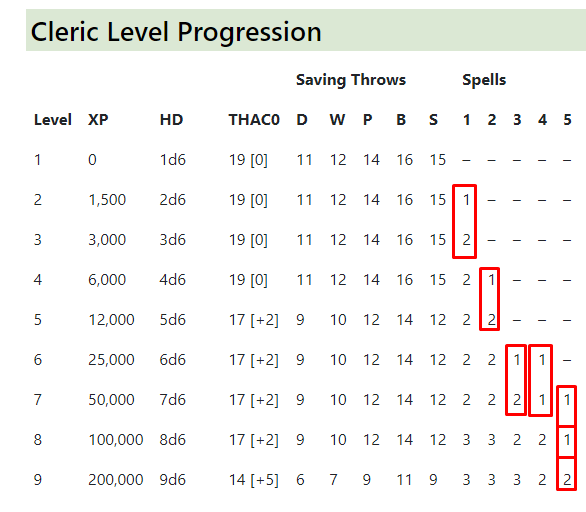In the original D&D, the cleric is a very peculiar class. Not only thematically (see "additional reading", below), but mechanically too.
At a first glance, the cleric casts spells exactly as a magic-user or elf - only starting a level later than both, and having a lower cap (5th level spells) when compared to the magic-user (6th level).
Once you dig a bit deeper, however, you will realize the clerics are completely different from other casters – most importantly because they can choose any spell to memorize, not being limited by a grimoire. However, there are other relevant details.
First, the cleric’s spell progression is very peculiar when compared to the magic-user and the elf. For example, a level 6 cleric gets access to spells of level 3 and 4 simultaneously for no obvious reason. Compare this to the magic-user: despite requiring a lot more XP to level up, the MU does not have access to level 4 spells until level 7.
And by level 7 (50,000 XP), the cleric can raise the dead! And, unlike the magic-user, he does so automatically, without needing to choose a spell to add to a grimoire.
From the OSE SRD:
This progression is in Moldvay's Basic (1981), identical to the one is OD&D. However, it is "fixed" for something more streamlined in both BECMI and AD&D.
Second, spell levels few almost arbitrary. Cure Light Wounds (healing 1d6+1 HP) is a 1st level spells, while Cure Serious Wounds (2d6+2 HP) is a fourth level spell. With a 5th level spell, you can raise the dead... or create lots of food.
Then there are deities, which will punish clerics that stray away from their path – or that cast reversed spells, making these kinds of spells a bit less versatile than they appear.
In practice, these things combine to make a more or less coherent whole. Spell levels are all over, but it does not really matter because the cleric can choose any spells every day. The cleric is very useful and versatile, but never a better fighter than the fighter, nor reaching the same destructive powers of a magic-user or elf.
However, there are some downsides.
For example, the game allows clerics to research their own spells, but there seems to be no obvious parameters on how to do so, since their spells vary so much in power. It also makes creating new classes who have access to both spell lists a lot harder, for the same reason.
Likewise, turn undead uses a strange progression that ALMOST makes sense if you take into account the creature's HD, as
OSE does:
As you can see, there is almost a very easy formula to be found ("roll 7+ or more to turn undead of the same HD as yours, 9+ if higher", etc.) that gets "broken" because of the addition of "HD 2*" monsters (which are ghouls, BTW; they seem to be important for some reason, giving the elf an special ability that looks almost pointless to me). OSE suggests adding higher HD monsters if desire; this is really easy to do if you follow a simple formula.
You might think that there is some unseen balance behind this reasoning. But this is not necessarily true. As someone else
mentioned, in
The Keep on the Borderlands - reviewed as "a good
introduction to D&D" (
source) - there are dozens of undead with amulets that prevent turning!
So, what can we do with this?
If you're playing B/X, OD&D, BECMI or OSE, you don't need to do anything, if you don't want to. In practice, as we've said, the cleric is not necessarily overpowered (especially if there are few undead in the campaign), and doesn't even heal that many HP (relying basically on CLW; which is good if you're healing 1d3 per day otherwise), despite being able to raise dead quite soon.
However, if you are writing your own house rules or OSR game and want to create a cleric more to your liking, you might consider:
- Streamlining spell progression and spell levels.
- Streamlining turn undead, especially if you don't need a column to accommodate ghouls.
- Giving more healing options if you want the cleric to be a healer.
- Change "raise dead" if you want it to be less common.
This is what I did in
Dark Fantasy Basic (making the cleric a weaker spell-caster than the MU and making turn undead a skill) and what I'm working on for my next supplement (an "Alternate Magic" book for OSE - let me know in the comments if you like the idea!).
Recommended reading:








